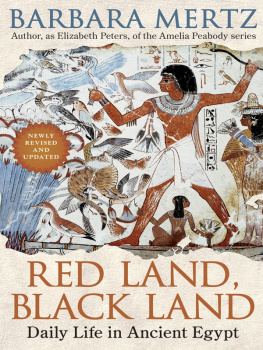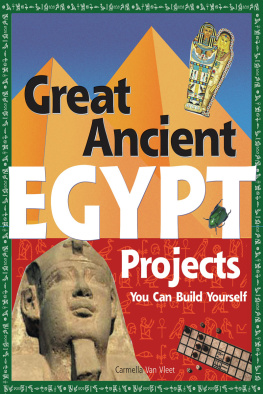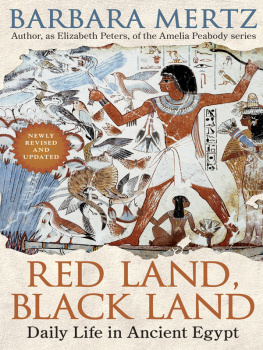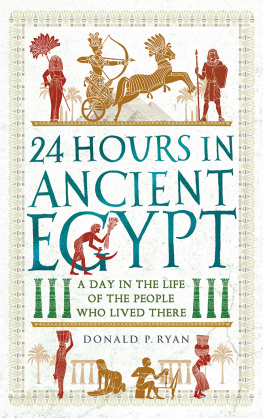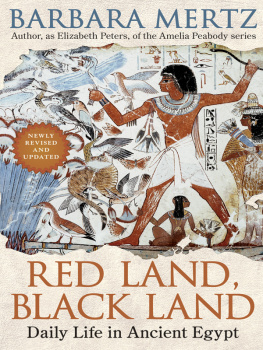T his is not a book about ancient Egyptian culture; it is a book about ancient Egyptians. It might even be subtitled How to Be an Ancient Egyptian, for, if properly studied, it will teach the reader how to make papyrus, how to build a pyramid, and how to dress, dine, and furnish a house in the Egyptian manner, among other matters of equal interest. The objects of our study are, for the most part, anonymous, but they are, or were, peoplehuman beingsEgyptians. I have tried, therefore, to talk about them as people, not as featureless statistics or as the vague blur of humanity underlying such academic topics as Egyptian Literature or Egyptian Architecture. The reader will not find a chapter on Egyptian Literature in this book, although a good many literary works are discussed. He will not find a chapter on Architecture either, but houses, temples, and tombs will be described. We do have a longish chapter on Egyptian Religion; however, the chapter on Costume is almost as long, although it concerns itself with a subject which is decidedly frivolous compared to theology. Yet I suspect that a well-to-do Egyptian lady, like her descendants in other countries and other ages, sometimes spent as much time thinking about her clothing as about her gods.
I apologized, in another book, for what might strike a sensitive reader as a frivolous approach to ancient Egypt, but I do not really believe that an apology is necessary. The popular view of Egyptian civilization as dignified and austere is incorrect. It comes from the massive temples, the grisly mummies, the crumbled and ruined tombs. Yet the temples were once bright with paint and aglitter with gold; the mummies were men, women, and children who enjoyed life so much that they went to unusual extremes in the hope of perpetuating it; the tombs were Houses of Eternity, equipped with every good and pure thing for the enjoyment of life everlasting. We are not insulting the Egyptians or falsifying their view of the world if we catch a glimpse of them telling bawdy stories about the gods, getting drunk, writing sentimental poems to their sweetheart, or lecturing their bored children. If we laugh at them just a little, it will not diminish them; and if we fail to see that we are also laughing at ourselves, we are missing the best part of the joke.
I n the forty-plus years since this book was written, it has been read by a good many people. I owe a great debt to these readers, some of whom went on to become professional Egyptologists, for helping to keep the book in print and for nagging me (in the kindest possible manner) to revise it. Since the original year of publication, hundreds of new books and thousands of new articles have appeared. The additions to one category are particularly striking: in the 1960s there were no books on the subject of Egyptian women. There are now quite a number of them, not to mention innumerable articles.
I wont claim Ive read all the new material, but I have read a good deal of it. I have made many trips to Egypt and talked with a number of obliging Egyptologists. And yet, I still stick to what I said in the foreword to the first edition. The refinements, the new information, the new interpretations of old data, really havent changed the picture as I see it. One may stress the differences between cultures such as our own and that of ancient Egypt, or one may insist on the fact that people ancient and modern, Western and Eastern, are basically much alike, with the same ambitions, dreams, and fears. It seems to me that in todays world it is all the more necessary to focus on the second approach.
Dating based on William Murnane, The Penguin Guide to Ancient Egypt , rev. ed. (Penguin Books, 1996).
Authors note: You will find different dates in different books; the further back in time, the greater the uncertainty. Chronologies are based on a number of sources, some more reliable than others. The general outline of dynasties comes from the Greek writer Manetho, who divided Egyptian history into families of rulers. Modern scholars have cast doubt on certain details, but the system has been in use so long that it would be inexpedient to change it.
You will sometimes encounter the terms C.E. (Common Era) and B.C.E. (Before the Common Era) instead of B.C. (Before Christ) and A.D. (Anno Domini). There is a reason for this, but I have been using the old terms too long to change.
ARCHAIC PERIOD: 31502686
Dynasty O: Scorpion, Aha, Narmer
Dynasty I: Unification; Menes, Djer, Djet, Den, Queen Merneith
Dynasty II: Peribsen, Khasekhemui
THE OLD KINGDOM: 26862181
Dynasty III: Step Pyramid; Djoser, Khaba, Huni
Dynasty IV: Pyramids of Dahshur, Medum, Giza; Snefru, Khufu, Khafre, Menkaure
Dynasty V: Userkaf, Sahure, Unis
Dynasty VI: Teti, Pepi I, Pepi II
FIRST INTERMEDIATE PERIOD: 21812040Breakdown of central government.
Dynasties VIIX. Some partially overlapping.
MIDDLE KINGDOM: 20401782Reunification.
Dynasty XI: Intefs and Mentuhoteps
Dynasty XII: Amenemhats and Senuserts, Queen Sobekneferu
SECOND INTERMEDIATE PERIOD: 17821570Breakdown of central government .
Dynasties XIIIXVI: Some overlapping. Hyksos
Dynasty XVII: Sekenenre Tao II, Kamose 1663l570
NEW KINGDOM: 15701070Reunification.
Dynasty XVIII: Ahmose, Amenhoteps and Thutmoses, Queen Hatshepsut, Akhenaton, Tutankhamon, Ay, Horemhab
Dynasty XIX: Seti I, Ramses I and II, Merneptah, Queen Tausert
Dynasty XX: Ramses IIIXI, Herihor
THIRD INTERMEDIATE PERIOD: 1070525
Dynasty XXI: Smendes, Psusennes, Pinudjem
Dynasty XXII: Libyan Sheshonks, Osorkons, Takelot
Dynasties XXIIIXXIV: Libyan
Dynasty XXV: Cushite; Piankhi, Shabaka, Taharka
Dynasty XXVI: Psamtiks (3), Necho, Apries
LATE PERIOD: 525332
Dynasty XXVII: First Persian
Dynasties XXVIIIXXIX: Egyptian dynasts
Dynasty XXX: Nectanabo I and II
Dynasty XXXI: Second Persian
PTOLEMAIC: Conquest by Alexander the Great, 332 B.C . Succeeded by Ptolemies and Cleopatras.
ROMAN: Conquest by Julius Caesar, 30 B.C . Egypt a Roman province.

